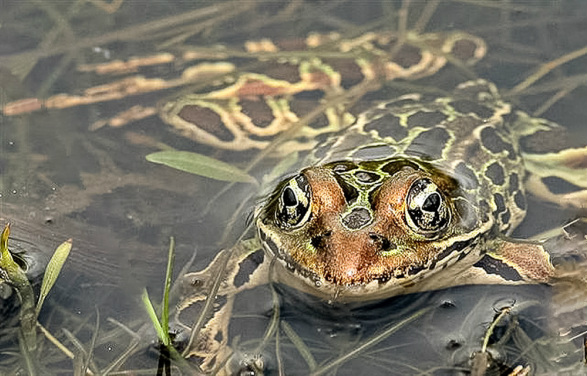Wetlands 3
I. Gigapan
This lesson uses a Bald Cypress swamp located in the Dupuis Management Area as its core. Let's go there and explore the Gigapans showing the Cypress and airplants. The snapshots have narrated slideshows. If necessary, review the lesson on how to navigate a Gigapan. Zoom in, pan around, explore the snapshots with their recorded slideshows.
Click: Dupuis Cypress Swamp
II. Snapshot Information and Images
Go to the menu bar and click on Lesson 15 to get the fly-out menu entitled "Wetlands 3 Snapshot Information and Images" for the words and images contained in the Gigapan snapshots.
III. Reference Photos
Go to the menu bar and click on Lesson 15 to get the fly-out menu entitled "Wetlands 3 Reference Photos" for a set of photos to help you identify Tillandsia airplants.
IV. Field Trip
It may be difficult or impossible to find a site to see several airplants at once. Trying to is not required. The Grassy Waters Boardwalk through a Bald Cypress swamp provides a fairly rich experience. Look into the Bald Cypress trees at all points along the walk, including the full length of the boardwalk side trip off the main loop. There's a lot of Northern Needleaf near the end of the side-trip.
If you go, take some pictures of any airplants you can, and any additional plants. Remember: put the photos in a Word doc and send it to us. Please do not send photos as separate e-mail attachments.
I. Gigapan
This lesson uses a Bald Cypress swamp located in the Dupuis Management Area as its core. Let's go there and explore the Gigapans showing the Cypress and airplants. The snapshots have narrated slideshows. If necessary, review the lesson on how to navigate a Gigapan. Zoom in, pan around, explore the snapshots with their recorded slideshows.
Click: Dupuis Cypress Swamp
II. Snapshot Information and Images
Go to the menu bar and click on Lesson 15 to get the fly-out menu entitled "Wetlands 3 Snapshot Information and Images" for the words and images contained in the Gigapan snapshots.
III. Reference Photos
Go to the menu bar and click on Lesson 15 to get the fly-out menu entitled "Wetlands 3 Reference Photos" for a set of photos to help you identify Tillandsia airplants.
IV. Field Trip
It may be difficult or impossible to find a site to see several airplants at once. Trying to is not required. The Grassy Waters Boardwalk through a Bald Cypress swamp provides a fairly rich experience. Look into the Bald Cypress trees at all points along the walk, including the full length of the boardwalk side trip off the main loop. There's a lot of Northern Needleaf near the end of the side-trip.
If you go, take some pictures of any airplants you can, and any additional plants. Remember: put the photos in a Word doc and send it to us. Please do not send photos as separate e-mail attachments.
IV. Practice
Our local Bromeliad "airplants" belong to the genus Tillandsia.
1. Which Tillandsia hangs like moss and has tiny flowers?
2. Which Tillandsia has knitting needle leaves?
3. How do you distinguish Northern Needleleaf from Cardinal Airplant?
4. What is Northern Needleleaf's favorite host tree?
5. Which Tillandsia favors scrub or dry pine woods? It is sometimes growing on the ground.
6. Which small Tillandsia is on the Oak trees in your back yard?
7. Name any plant that is not a Bromeliad but is an "airplant" What is the botanical term from Lesson 1 for an "airplant"?
8. What wetland herb has three very delicate white petals per flower?
9. What tree or shrub has leaves fragrant when crushed, grayish undersides, and often has galls?
10. Which Milkwort is tall, lives in a marsh, has yellow flowers, and a branched inflorescence?
VI. Quiz
Quiz 15
Our local Bromeliad "airplants" belong to the genus Tillandsia.
1. Which Tillandsia hangs like moss and has tiny flowers?
2. Which Tillandsia has knitting needle leaves?
3. How do you distinguish Northern Needleleaf from Cardinal Airplant?
4. What is Northern Needleleaf's favorite host tree?
5. Which Tillandsia favors scrub or dry pine woods? It is sometimes growing on the ground.
6. Which small Tillandsia is on the Oak trees in your back yard?
7. Name any plant that is not a Bromeliad but is an "airplant" What is the botanical term from Lesson 1 for an "airplant"?
8. What wetland herb has three very delicate white petals per flower?
9. What tree or shrub has leaves fragrant when crushed, grayish undersides, and often has galls?
10. Which Milkwort is tall, lives in a marsh, has yellow flowers, and a branched inflorescence?
VI. Quiz
Quiz 15

